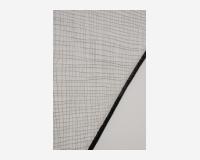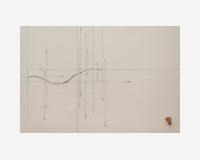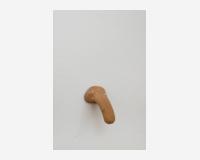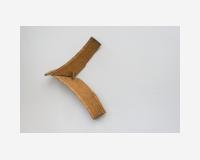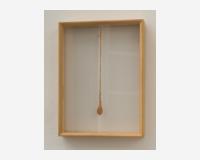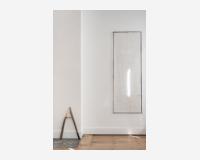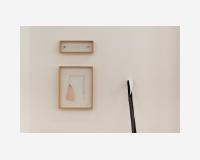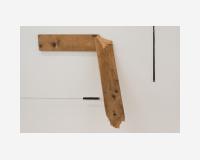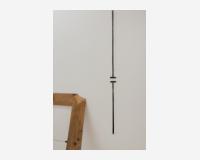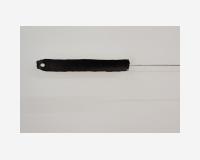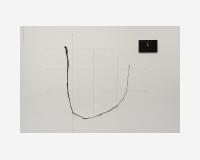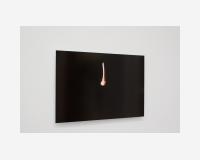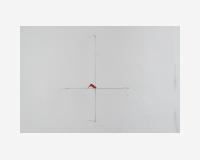"Voir que ça tient" Eva Steynen Gallery, Antwerp 2025
un A pour écouter si c'est vrai
an A to listen if it's true
2025
wood, paint
56 x 33,5 x 30 cm
https://galleryviewer.com/en/article/3164/seeing-that-it-holds-benoit-fe...
"Seeing that it holds: Benoît Felix, solo exhibition at Eva Steynen Gallery" by Emily Van Driessen
(ENG)
Benoît Felix: “ I don't know. That's my starting point. Or rather, my starting line. It's as if I had to draw a line through knowing what I was going to do in order to begin. What I saw in that line was a drawing—not the drawing of something—rather the mark of a negation? That of a separation from what would otherwise have held me back from doing? This line drawn in front of me (most often at my feet) was also an edge: the edge of something that could then happen.
It is perhaps also as if I had to trace for myself the horizon towards which I was moving. Let me illustrate with this event: I am splitting wood for the winter. Suddenly something is there, there in front of me: "See that it holds." One of these pieces of wood, by the particular form it has taken - a form of resistance - stops me in my enterprise - that of splitting, breaking, cutting, reducing. It is a presence that I recognize there - and at the same time the destructive dimension of my enterprise appears to me: I suddenly say to myself that it would be good if others besides me could also see the destructive dimension of their enterprise and therefore stop.
What I suddenly see is that "It holds." It's actually the same thing I say to myself in the studio when suddenly what I was working on is imposed on me as - let's say the work - cutting, reducing, making holes, stretching it differently to the wall or to the space to see if it wouldn't look better... No, no! The question is suddenly no longer whether it's better: it's there. What's there is neither better nor worse than anything else; it's there.
"Voir que ça tient," "Templum," but also "Concetto spaziale," you'll see, it's a series of encounters. While I thought I was busy with something else entirely, it's also suddenly, faced with the obvious fact that I was making art, that I suddenly found myself there in front of it? And what do I see? I see that I didn't know.”
(NL)
Benoît Felix: "Ik weet het niet. Dat is mijn uitgangspunt. Of liever gezegd, mijn startlijn. Het is alsof ik een grens moest trekken door te weten wat ik ging doen om te kunnen beginnen. Wat ik in die lijn zag, was een tekening – niet de tekening van iets – eerder het teken van een ontkenning? Van een scheiding van wat me anders zou hebben tegengehouden? Deze lijn, getekend voor me (meestal aan mijn voeten), was ook een rand: de rand van iets dat dan zou kunnen gebeuren.
Het is misschien ook alsof ik zelf de horizon moest traceren waar ik naartoe bewoog. Laat ik het met deze gebeurtenis illustreren: ik ben hout aan het kloven voor de winter. Plotseling is er iets, daar voor me: 'Kijk of het houdt.' Een van deze stukken hout, door de specifieke vorm die het heeft aangenomen – een vorm van weerstand – houdt me tegen in mijn onderneming – die van splijten, breken, snijden, reduceren. Het is een aanwezigheid die ik daar herken – en tegelijkertijd verschijnt de destructieve dimensie van mijn onderneming aan me: ik zeg plotseling tegen mezelf dat het goed zou zijn als anderen, behalve ikzelf, ook de destructieve dimensie van hun onderneming zouden zien en daarom zouden stoppen.
Wat ik ineens zie, is: 'Het houdt stand.' Het is eigenlijk hetzelfde wat ik in de studio tegen mezelf zeg, wanneer datgene waar ik aan werkte me ineens wordt opgedrongen als - laten we zeggen het werk - knippen, verkleinen, gaten maken, het anders oprekken tegen de muur of de ruimte om te kijken of het er niet beter uitziet... Nee, nee! De vraag is ineens niet meer of het beter is: het is er. Wat er is, is niet beter of slechter dan wat dan ook; het is er.
'Voir que ça tient', 'Templum', maar ook 'Concetto spaziale', je zult zien, het is een reeks ontmoetingen. Terwijl ik dacht dat ik met iets heel anders bezig was, is het ook plotseling, geconfronteerd met het overduidelijke feit dat ik kunst maakte, dat ik me er plotseling voor bevind? En wat zie ik? Ik zie dat ik het niet wist."
(FR)
Je ne sais pas. Voilà mon point de départ. Ou plutôt ma ligne de départ. C’est comme s’il m’avait fallu tirer un trait sur le fait que je sache ce que j’allais faire pour commencer. Ce que j’ai vu dans ce trait c’est un dessin – pas le dessin de quelque chose : plutôt la marque d’une négation ? Celle d’une séparation d’avec ce qui m’aurait sinon retenu de faire ? Cette ligne tracée devant moi (le plus souvent à mes pieds) était aussi un bord: le bord de quelque chose qui pourrait alors se produire.
C’est peut-être aussi comme s’il m’avait fallu tracer par moi-même l’horizon vers lequel m’avancer. Je fends du bois pour l’hivers. Tout à coup quelque chose est là, là devant moi: « Voir que ça tient ». L’un de ces morceaux de bois, par la forme particulière qu’il a pris – une forme de résistance – m’arrête dans mon entreprise – celle de fendre, de casser, de couper, de réduire. C’est une présence que j’y reconnais – et dans le même temps m’apparaît la dimension destructrice de mon entreprise : je me dis soudain qu’il serait bon que d’autres que moi puissent voir eux aussi la dimension destructrice de leur entreprise (leur entreprise privée, leur entreprise d’état…), et donc s’arrêter.
« Ça tient ». C’est en fait la même chose que je me dis dans l’atelier quand tout-à-coup s’impose à moi comme – disons: "l’oeuvre" (ce à quoi j’étais en train de travailler – découpant, réduisant, trouant, tendant autrement au mur ou dans l’espace pour voir si ça ne donnerait pas mieux...). Non, non! La question n’est alors plus que ce soit mieux: c’est là.
Ce qui est là n’est ni mieux ni moins bien qu’autre chose, c’est là.
« Voir que ça tient », « Templum », mais aussi « Concetto spaziale », vous verrez, c’est une série de rencontres. Alors que je pensais être occupé à tout autre chose c’est aussi soudain face à l’évidence que je faisais de l’art (déjà) que je me retrouve tout d’un coup là devant? Je ne le savais pas, je faisais du bois. Et qu’est-ce que je vois? Je vois que je ne savais pas.
Benoît Felix, 7 aout 2025



